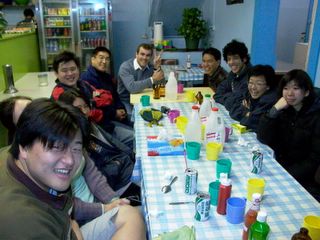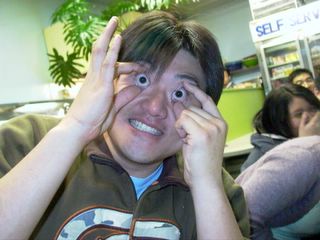忍耐 + 掌握人生
Russian National Team Members Visit
UNSW on Monday
Monday was a big day. The 3 Russian national team members - Vitaly, Maxim and Sergei joined the UNSW training, and Ka-bi who usually doesn't attend Monday training also came to lead the class until Sano sensei arrived.
It was a massive rush for me on Monday evening to go home and get the car to pick up the Russians in Gordon at 7pm. By now, I have perfected the all important skills of slipping in and out of office without too much attention, a skill that I acquired well as my kendo year grows. Ayumi-ashi in stealth serves me very well in these occassions. This is how you apply kendo into your daily life.
Anyway, I drove Maxim, Vitaly and Sergey and we arrived to UNSW at around 7:30pm. When we stepped out of the car, we could hear the loud kiai coming all the way from the dojo to the parking lot.
While we were walking upstairs to the dojo, I could hear Kirby was at the dojo entrance greeting Max and Sergey who were walking ahead of me. Kirby also joined the Monday training which was quite unusual as he usually train on Thursday only.
Kirby led the training and we practiced kirikaeshi (slow and fast), kihon-geiko, kote-do and hiki-men.
One-Breath Men Cuts
Sano Sensei arrived half-way through the training, and we did some new men-uchi exercises -cutting as many men cuts as possible in one breath, and we did that for a few rotations. I was able to do up to five men-cuts in one breath.
In the second new men-uchi exercise, Sano sensei instructed us to do as many men cuts in 10 seconds as possible. I was able to do six cuts in 10 seconds, while the highest number in the class was 7, with Michael Henstock close to scoring 8 cuts if he made the 8th cut 0.1 second faster.
In the above two exercises, motodachi has an active and important role in keeping the connection with the person doing the exercises, so that the person practicing could launch the next attack as soon as they turned around from their previous cut.
Afterwards, we had many rounds of mawari-jigeiko. During the rotations, I had the chance to pair up with Sergey and Vitaly.
Sergey was very fast, strong and explosive in his cuts with nice orthodox kendo. Personally, I think he is the strongest of the three. His tokui waza is kote - debana kote, hiki-kote. And he is only 18. He is a force to reckon with, and I can see a lot of future in him.
By the time I was rotated to play Vitaly, my mind and body were very well warmed-up. I landed a few debana-kote, and he retaliated with his explosive fast men cuts and ocassional kote.
From 9pm, we had 30mins free jigeiko. I brought my video-camera to trainingonce again, and taped my matches with Sergey, Michael Henstock and Sano Sensei.
Winning Factor: Mental Strength, Not Physical Ability
I played my last keiko of the night with Sano Sensei. It was an ippon keiko, and lasted for 8 full intensed minutes. I put everything into the game, and there were a few moments when I thought I had cut Sensei's kote, but the cuts didn't convince Sensei and so no point was awarded. I kept trying my best to go for cuts, but it was so difficult to make that ippon happened. My body was getting tired at that stage, and there was one moment late in the jigeiko where there was an open opportunity to make a perfect men-ari, but my mind was not strong enough to grab the moment, and my shinai slipped off the men. I think it is the hardest to keep the mind strong even when physical exhaustion is coming to you. But I must be learn to be prepared for that, as the deciding point of a big match is usually decided by mental strength and not physical ability.
More Power in Cut
At the end of training, I asked for feedbacks from Sano Sensei. He said my men cut was too light and needed more power in the cut to make that ippon scoring sound.
I also asked about what was lacking in my kote cut to warrant an ippon. Sano Sensei said he might have been tough on me, and some shinpans might give me the point. But that still didn't convince me. There must be a reason to why Sano Sensei didn't give me the point. Sano Sensei said there was something lacking, but he couldn't pinpoint where the problem was, and suggested me to look at the video-tapes myself for clues.
After training finished at 9:30pm. About 15 people went to Kirby's house in Bondi to have a welcoming party for the Russians. We had pasta and watched the DVD brought in by the Russians about their training and dojo back in Vladivostok. One thing I saw in that DVD which I really like was their kendo training dummy. Using simple mechnical parts such as coils and shock absorber, Sergey and Vitaly created a very well-functioned 80kg training dummy which imitates real human movements very well. It allows you to practice everything from learning to break opponent's kensen to hiki-waza. Best of all, it won't scream at you if you miss a cut. I would love to a training dummy like that too.
We watched some more kendo videos before departing at 2am. It was a long but fun day out.
Willoughby on Wednesday
I drove the 3 Russians to Willoughby dojo for the 7:30pm start. Takashi Itakura Sensei led the training session that night, and we had a few Kim's from Master Choi's dojo joining the training too.
For the first 20mins, I paired up with Sergey to run through Kata 1-7 in both motodachi and shidachi roles three times. The whole class then did stretching and warm-up together, before putting our men and kote on.
The training focused on the basics. We had a lot of good quality basic ashi-sabaki practices up and down the dojo. I again paired up with Sergey, and we did the following exercises along the full length of the dojo:
- okuri-ashi x 10 return trips
- suri-ashi x 10 return trips
- kote-men in super fast little jumpy steps x 5 return trips
- 3 sets of full kirikaeshi along the full length of the dojo (focus on accurate men cut. So we did the men cuts in a relatively slow speed but of very high quality)
- men-uchi x 3
- kote-uchi x 3
- do-uchi x 3
- kote-men x 3
追い込み稽古 (小手-面)
One thing to watch out for when practicing the super fast jumpy machine-gun styled kote-men is that left heel must always be lifted off the ground.
In the last 15mins, we had ippon-shobu jigeiko. Itakura Sensei emphasised that we should each have one goal to achieve during the jigeiko session. For Sensei himself, his goal was tried not to waver in reaction to opponent's movements. To form good kamae and keep strong kensen at all time.
I had keiko with Sergey, Vitaly, Maxim and Hyun-Duk Kim.
I realised after the jigeiko that my body was not moving in/forward during the cut. My men cut was really lacking the forward momentum. I should try to propel my whole body forward in my cuts.
Another thing I noticed about my cuts was that, I started my cuts from too great a distance. It is good to be able to jump from a great distance to attack my opponent. However, it is very hard to create pressure on my opponent when there is a big distance between me and my opponent.
My Goals in Doing Men-uchi:
- Seme, seme, seme...
- ...until my seme beat opponent's centre-line;
- move in immediately to the attacking zone;
- using forward momentum, propel whole body forward to cut men;
- follow through cut with quick suri-ashi and good zanshin.










 Name: Vivian Yung
Name: Vivian Yung